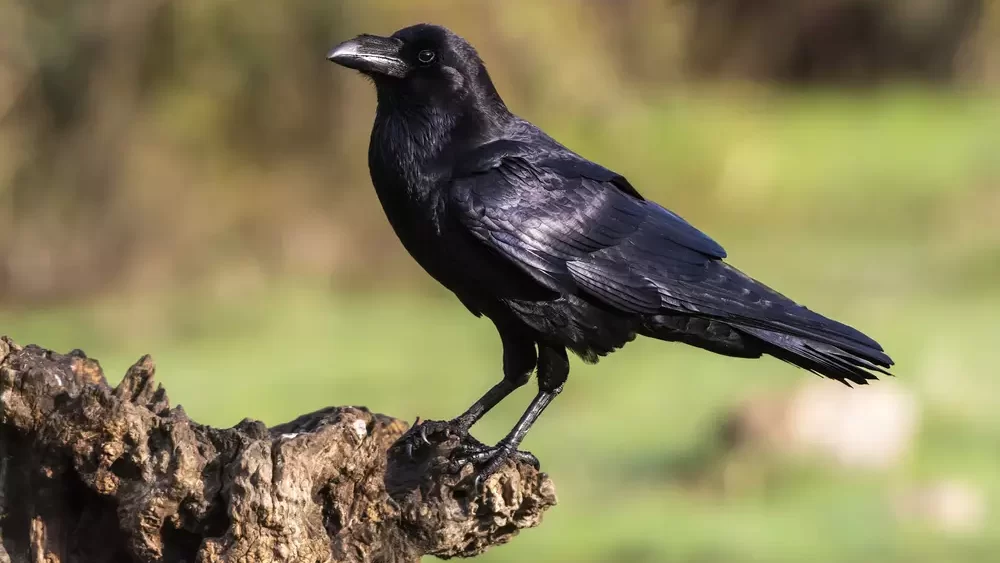Ravens are truly fascinating creatures with remarkable intelligence and an air of mystique.
Known for their sleek black plumage, captivating flight patterns, and prominent role in mythology and folklore, ravens have captivated our imagination for centuries.
But have you ever wondered about the speed of these remarkable birds? Let’s dive into the world of ravens and discover just how fast they can fly.
Raven: An Overview
Before we dive into the specifics of their flight speed, let’s get a better understanding of ravens as a species.
Ravens belong to the Corvidae family, which also includes crows, magpies, and jays. The common raven, Corvus corax, is the largest member of the family and can be found across the Northern Hemisphere.
Ravens are known for their intelligence, adaptability, and complex social structures. They have been observed using tools, solving problems, and even playing games with one another.
Their vocalizations are incredibly diverse, and they are capable of mimicking sounds from their environment, including human speech.
Raven Flight Patterns
The flight patterns of ravens are as fascinating as their intellect. They are agile and acrobatic, often engaging in aerial displays that showcase their prowess.
Ravens have been observed performing barrel rolls, steep dives, and even flying upside down for short distances.
In general, ravens are strong flyers that can cover long distances with relative ease.
They have a unique flight style characterized by alternating between flapping and gliding, which allows them to conserve energy while maintaining speed.

Factors Affecting Flight Speed
Several factors influence the speed at which a raven can fly. These include the bird’s wingspan and body structure, weather conditions, and altitude.
Wingspan and Body Structure
The wingspan of a raven typically ranges from 3.8 to 4.7 feet, with an average body length of 24 to 27 inches. Their wings are broad and rounded, allowing for powerful flight and impressive maneuverability.
These physical adaptations enable the raven to reach speeds of up to 25 miles per hour (40 kilometers per hour) in level flight.
Weather Conditions
Weather conditions also play a significant role in a raven’s flight speed. Tailwinds can help ravens reach higher speeds, while headwinds may slow them down.
Additionally, thermals and updrafts can provide lift, enabling ravens to soar and glide with minimal effort.
Altitude
The altitude at which a raven flies can also affect its speed. As altitude increases, the air becomes thinner, resulting in less air resistance. This allows ravens to fly faster at higher altitudes.
However, the reduced air pressure and oxygen levels can also make it more challenging for them to maintain their speed. Thus, ravens need to strike a balance between altitude and flight efficiency.
Raven Speed in Comparison to Other Birds
While ravens are relatively fast flyers, they are not the fastest birds in the world. The peregrine falcon, for example, can reach speeds of over 240 miles per hour (386 kilometers per hour) in a dive.
However, ravens are still considered faster than many bird species, particularly those with similar body structures.
In comparison to other members of the Corvidae family, ravens are among the fastest.
Crows, for instance, can reach speeds of up to 20 miles per hour (32 kilometers per hour), while magpies can fly at approximately 15 miles per hour (24 kilometers per hour).

The Significance of Speed in Raven Behavior
The speed and agility of ravens play a crucial role in their daily lives. It allows them to efficiently search for food, evade predators, and engage in complex social interactions with other ravens.
Their speed also enables them to cover vast territories, which is particularly important for the nomadic and migratory populations.
Furthermore, the impressive flight skills of ravens are essential for their courtship rituals.
Males will often perform acrobatic displays to attract females, showcasing their strength and dexterity.
Ravens in Folklore and Symbolism
Ravens have held a prominent place in human culture for thousands of years, often symbolizing wisdom, intelligence, and mystery.
In Norse mythology, the god Odin is accompanied by two ravens named Huginn (thought) and Muninn (memory), who fly across the world to gather information.
Native American tribes also hold ravens in high regard, viewing them as tricksters and creators.
The raven’s speed and agility in flight have undoubtedly contributed to their mythical status, as their ability to cover vast distances and navigate complex environments is awe-inspiring.
Threats to Ravens and Conservation Efforts
Despite their adaptability and widespread distribution, ravens are not immune to the effects of habitat loss, climate change, and human activity.
In some regions, populations have declined due to persecution, poisoning, and the destruction of nesting sites.
Conservation efforts for ravens include habitat preservation, monitoring populations, and implementing regulations to protect the species.
Public awareness and education are also crucial to ensure the long-term survival of these remarkable birds.
How to Observe Ravens in the Wild
If you’re interested in observing ravens in their natural habitat, consider visiting national parks, forests, or other natural areas where they are known to reside.
Keep your distance and use binoculars to watch them without causing disturbance. Pay attention to their flight patterns, vocalizations, and social interactions for a glimpse into their complex and fascinating world.
In Flight with the Raven: Final Thoughts
Ravens are extraordinary birds, boasting remarkable intelligence, striking appearance, and captivating flight abilities.
With a top speed of 25 miles per hour (40 kilometers per hour), they stand out as one of the fastest members of the Corvidae family.
Their speed, combined with their agility and strength, contributes to their success as a species and enhances their appeal in folklore and mythology.
By understanding the factors that influence their flight speed and appreciating the role it plays in their lives, we can better grasp the beauty and complexity of these fascinating creatures.
As we strive to protect and conserve the raven and its habitat, we also preserve the enchanting stories and symbolism that have captivated us for centuries.
